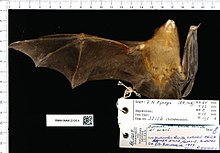The African trident bat (Triaenops afer) is a species of rhinonycterid (leaf-nosed or nose-leaf) bat found in Africa, from western Central Africa east to coastal Kenya and Mozambique.[2]
| African trident bat | |
|---|---|

| |
| Scientific classification | |
| Domain: | Eukaryota |
| Kingdom: | Animalia |
| Phylum: | Chordata |
| Class: | Mammalia |
| Order: | Chiroptera |
| Family: | Rhinonycteridae |
| Genus: | Triaenops |
| Species: | T. afer
|
| Binomial name | |
| Triaenops afer Peters, 1877
| |
| Synonyms | |
| |
Taxonomy and etymology
editThe African trident bat, Triaenops afer, was first described as a new species in 1877 by German zoologist, Wilhelm Peters.[3] From around 1963 through 2009, the species had been considered a subspecies of the Persian or rufous trident bat (T. persicus), until morphological and genetic analyses showed that it was a distinct species.[4] The generic name Triaenops, from the Greek τριαινόψ ("triainóps"), means "trinity" and possibly refers to the three "points" or openings on the bat's nose, while the specific name "afer" is Latin for "African".
Biology and ecology
editIt is nocturnal, roosting in sheltered places during the day such as caves or abandoned mines. Roosts can consist of up to half a million individuals, as this is a colonial species.[1]
Range and habitat
editTriaenops afer has been documented in Eritrea, Ethiopia (Oromia), Mozambique (Inhambane Province), south Kenya (Kwale, Kilifi, Mombasa, Taita-Taveta Counties), and the southwest of the Republic of the Congo (near the southern Gabon border) into northwestern Angola.[4] Previously thought to be the only species of Triaenops found on mainland Africa, modern morphological, genetic and echolocation analyses have shown that the Rift Valley Triaenops bats, in Kenya, are actually the related Persian trident bat, T. persicus.[5] Elsewhere in the country, including along the Indian Ocean coastline, as well as in the Ethiopian Highlands, the bats were indeed found to be T. afer.[5]
References
edit- ^ a b Monadjem, A.; Shapiro, J. (2017). "Triaenops afer". The IUCN Red List of Threatened Species. 2017: e.T81081036A95642225. doi:10.2305/IUCN.UK.2017-2.RLTS.T81081036A95642225.en.
- ^ African trident bat, distribution (6 November 2024). "Observations • iNaturalist".
{{cite web}}: CS1 maint: url-status (link) - ^ Peters, W. (1876). "Mittheilung über eine kleine Sammlung von Säugethieren, welche der Reisende Hr. JM Hildebrandt aus Mombaca in ostafrica eingesand hat". Monatsberichte der Königlichen Preussische Akademie des Wissenschaften zu Berlin. 1876: 913.
- ^ a b Benda, P.; Vallo, P. (2009). "Taxonomic revision of the genus Triaenops (Chiroptera: Hipposideridae) with description of a new species from southern Arabia and definitions of a new genus and tribe" (PDF). Folia Zoologica. 58 (1). Archived from the original (PDF) on 2017-09-16. Retrieved 2018-03-10.
- ^ a b Rossoni, Daniela M.; Demos, Terrence C.; Goodman, Steven M.; Yego, Richard K.; Mohlman, Jessica L.; Webala, Paul W.; Patterson, Bruce D. (2021). "Genetic, morphological and acoustic differentiation of African trident bats (Rhinonycteridae: Triaenops)". Zoological Journal of the Linnean Society. 192 (1): 236–257. doi:10.1093/zoolinnean/zlaa098.
